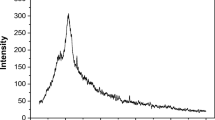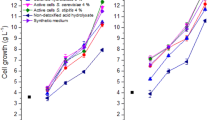Abstract
Textile industries use large amounts of water in dyeing processes and a wide variety of synthetic dyes. A small concentration of these dyes in the environment can generate highly visible pollution and changes in aquatic ecosystems. Adsorption, biosorption, and biodegradation are the most advantageous dye removal processes. Biodegradation occurs when enzymes produced by certain microorganisms are capable of breaking down the dye molecule. To increase the efficiency of these processes, cell immobilization enables the reuse of the immobilized cells and offers a high degree of mechanical strength, allowing metabolic processes to take place under adverse conditions. The aim of the present study was to investigate the use of Saccharomyces cerevisiae immobilized in activated sugarcane bagasse for the degradation of Acid Black 48 dye in aqueous solutions. For such, sugarcane bagasse was treated with polyethyleneimine (PEI). Concentrations of a 1 % S. cerevisiae suspension were evaluated to determine cell immobilization rates. Once immobilization was established, biodegradation assays for 240 h with free and immobilized yeast in PEI-treated sugarcane bagasse were evaluated by Fourier transform infrared spectrophotometry. The results indicated a probable change in the dye molecule and the possible formation of new metabolites. Thus, S. cerevisiae immobilized in sugarcane bagasse is very attractive for biodegradation processes in the treatment of textile effluents.







Similar content being viewed by others
References
Abbas, O., Rebufa, C., Dupuy, N., & Kister, J. (2008). FTIR-multivariate curve resolution monitoring of photo-Fenton degradation of phenolic aqueous solutions. Comparison with HPLC as a reference method. Talanta, 77, 200–209.
Aliprandini, P. 2010. Primer de poli(5-amino-1-naftol) obtido por eletrossíntese (Primer of poly (5-amino-1-naphthol) obtained by eletrosinthesis). BSc Thesis, Material Engineering, University of Rio Grande do Sul, Porto Alegre, Brazil.
Almeida, A.C.M. (2008). Estudo da biodegradação de corantes azóicos por inóculo proveniente de biodigestor anaeróbio de alimentos (Study of azo dye biodegradation by anaerobic digester inoculum from food). MSc Thesis, Applied Microbiology, São Paulo State University, Rio Claro, Brazil.
Amin, N. K. (2008). Removal of reactive dye from aqueous solutions by adsorption onto activated carbons prepared from sugarcane bagasse pith. Desalination, 223, 152–161.
Arjunan, V., Subramanian, S., Mohan, S. (2004). FTIR and FTR spectral studies of 2-amin-6-bromo-3-formylchromone. Spectrochimica Acta Part A: Molecular and Biomolecular Spectroscopy, 60(5), 995–1000.
Barbosa, L. C. A. (2007). Espectroscopia no Infravermelho na Caracterização de Compostos Orgânicos (Infrared Spectroscopy in Organic Compounds Characterization). Viçosa: UFV editora.
Cherdoud-Chihani, A., Mouzali, M., & Abadie, M. J. M. (2003). Study of crosslinking acid copolymer/DGEBA systems by FTIR. Journal of Applied Polymer Science, 87, 2033–2051.
Devi, G., Devi, T. S. R., & Gunasekaran, S. (2010). FTIR spectroscopy study and cancerous human breast tissues – a run chart analysis. International Journal of Pharmaceutical Sciences Review and Research, 2(2), 73–77.
Devi, T. S. R., & Gayathri, S. (2010). FTIR and FT-Raman spectral analysis of paclitaxel drugs. International Journal of Pharmaceutical Sciences Review and Research, 2(2), 106–110.
Dhanve, R. S., Kalyani, D. C., Phugare, S. S., & Jadhav, J. P. (2009). Coordinate action of exiguobacterial oxidoreductive enzymes in biodegradation of reactive yellow 84A dye. Biodegradation, 20, 245–255.
Dutra, R.C.L., Takahashi, M.F.K., Diniz, M.F. (1995). Importância da preparação de amostras em espectroscopia no infravermelho com transformada de Fourier (FTIR) na investigação de constituintes em materiais compostos (Importance of preparing samples for infrared spectroscopy Fourier transform (FTIR) to investigate constituents in composite materials). Polímeros: Ciência e Tecnologia, Jan/Mar, 41–47.
Dyer, J. R. (1969). Aplicações de Espectroscopia de Absorção aos Compostos Orgânicos (Applications of Absorption Spectroscopy of Organic Compounds). Sao Paulo: Edgard Blucher.
El-Kabbany, F., Taha, S., & Hafez, M. (2010). IR spectroscopic analysis of polymorphism in diphenyl carbazide. Journal of American Science, 6(80), 263–270.
Evora, M. C., Gonçalez, O. L., Dutra, R. C. L., Diniz, M. F., Wiebeck, H., & Silva, L. G. A. (2002). A comparison of transmission, reflection and photoacoustic FTIR techniques in the analysis of recycled and irradiated polyamide-6. Polímeros: Ciência e Tecnologia, 12(1), 60–68.
Fanchiang, J. M., & Tseng, D. H. (2009). Degradation of anthraquinone dye C.I. Reactive Blue 19 in aqueous solution by ozonation. Chemosphere, 77(2), 214–221.
Farsani, R. E., Raissi, S., Shokuhfar, A., & Sedghi, A. (2009). FT-IR study of stabilized PAN fibers for fabrication of carbon fibers. World Academy of Science, Engineering and Technology, 50, 430–433.
Lu, X., & Liu, R. (2010). Treatment of azo dye-containing wastewater using integrated processes. In H. A. Erkut (Ed.), Biodegradation of azo dyes (pp. 133–155). Heidelberg: Springer-Verlag.
Mitter, E. K., Santos, G. C., Almeida, E. J. R., Morão, L. G., Rodrigues, H. D. P., & Corso, C. R. (2012). Analysis of acid alizarin violet N dye removal using sugarcane bagasse as adsorbent. Water, Air, and Soil Pollution, 223(2), 765–770.
Mitter, E. K., & Corso, C. R. (2012). Acid dye biodegradation using Saccharomyces cerevisiae immobilized with polyethyleneimine-treated sugarcane bagasse. Water, Air, and Soil Pollution, 224, 1391.
Nigam, P., Armour, G., Banat, I. M., Singh, D., & Marchant, R. (2000). Physical removal of textile dyes from effluents and solid-state fermentation of dye-adsorbed agricultural residues. Bioresource Technology, 72, 219–226.
Ogugbue, C. J., & Sawidis, T. (2011). Bioremediation and detoxification of synthetic wastewater containing triarylmathane dyes by Aromonas hydrophila isolated from industrial effluents. Biotechnology Research International, 2011, 1–11.
Oliveira, M. M., Pimenta, M. E. S. G., Camargo, A. C. S., Fiori, J. E., & Pimenta, C. J. (2006). Silage of tilapia (Oreochromis niloticus) filetage residues with formic acid—bromatological, physicochemical and microbiological analyses. Ciências Agrotecnicas de Lavras, 30(6), 1218–1223.
Passos, C.T. (2006). Estudo da biodegradação do fenol por uma nova linhagem de Aspergillus sp. (Study of phenol biodegradation by a new strain of Aspergillus sp.). MSc Thesis, Engineering and Food Science, Rio Grande do Sul Federal University, Rio Grande, Brazil.
Pearce, C. I., Lloyd, J. R., & Guthrie, J. T. (2003). The removal of colour from textile wastewater using whole bacterial cells: a review. Dyes and Pigments, 58, 179–196.
Peruzzo, L.C. (2003). Influência de agentes auxiliares na adsorção de corantes de efluentes da indústria têxtil em colunas de leito fixo (Influence of auxiliary dye adsorption in textile industry effluents fixed bed columns). MSc Thesis, Chemical Engeneering, Santa Catarina Federal University, Florianópolis, Brazil.
Rajaguru, P., Kalaiselvi, K., Palanivel, M., & Subburam, V. (2000). Biodegradation of azo dyes in a sequential anaerobic–aerobic system. Applied Microbiology and Biotechnology, 54, 268–273.
Reis, R. A., Jr., & Monnerat, P. H. (2002). Diagnose Nutricional Da Cana-De-Açúcar Em Campos Dos Goytacazes-RJ (Nutritional diagnosis of sugarcane bagasse from Campos Dos Goytacazes-RJ). Revista Brasileira de Ciência do Solo, 26, 367–372.
Romão, B. M. V., Diniz, M. F., Azevedo, M. F. P., Lourenço, V. L., Pardini, L. C., Dutra, R. C. L., & Burel, F. (2003). Characterization by FT-IR of curing agents used in epoxy resins. Polímeros: Ciência e Tecnologia, 13(3), 173–180.
Royer, B. (2008). Remoção de Corantes Têxteis Utilizando Casca de Semente de Araucaria angustifólia como Biossorvente (Removal of Textile Dyes Using Araucaria angustifolia Bark Seed as biosorbent). MSc Thesis, Federal University of Rio Grande do Sul, Porto Alegre, Brazil.
Silverstein, R.M., Bassler, G.C., Morril, T.C. (1979). Identificação Espectrométrica de Compostos Orgânicos (Spectrometric Identification of Organic Compounds). Guanabara: Koogan, Rio de Janeiro, Brazil.
Silverstein, R.M., Bassler, G.C., Morrill, T.C. (1994). Identificação Espectrométrica de Compostos Orgânicos (Spectrometric Identification of Organic Compounds). Guanabara: Koogan, Rio de Janeiro, Brazil.
Song, S. H., Choi, S. S., Kyungmoon, P., & Yoo, Y. J. (2005). Novel hybrid immobilization of microorganisms and its applications to biological denitrification. Enzyme and Microbial Technology, 37(6), 567–573.
Stuart, B. (2004). Infrared spectroscopy: fundamentals and applications (p. 244). London: John Wiley & Sons Ltd.
Suksombat, W. (2004). Comparison of different alkali treatment of bagasse and rice straw. Asian–Australasian Journal of Animal Sciences, 17(10), 1430–1433.
Sumbu, Z. L., Thonart, P., & Bechet, J. (1983). Action of patulin on a yeast. Applied and Environmental Microbiology, 45(1), 110–115.
Vitor, V., & Corso, C. R. (2008). Decolorization of textile dye by Candida albicans isolated from industrial effluents. Journal of Industrial Microbiology and Biotechnology, 35(11), 1353–1357.
Wharfe, S. E., Jarvis, R. M., Winder, C. L., Whiteley, A. S., & Goodacre, R. (2010). Fourier transform infrared spectroscopy as a metabolite fingerprinting tool for monitoring the phenotypic changes in complex bacterial communities capable of degrading phenol. Environmental Microbiology, 12(12), 3253–3263.
Author information
Authors and Affiliations
Corresponding author
Rights and permissions
About this article
Cite this article
Mitter, E.K., Corso, C.R. FT-IR Analysis of Acid Black Dye Biodegradation Using Saccharomyces cerevisiae Immobilized with Treated Sugarcane Bagasse. Water Air Soil Pollut 224, 1607 (2013). https://doi.org/10.1007/s11270-013-1607-0
Received:
Accepted:
Published:
DOI: https://doi.org/10.1007/s11270-013-1607-0




